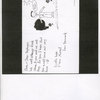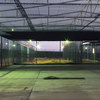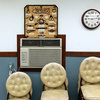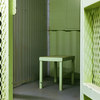Review: Guantanamo: If The Light Goes Out by Edmund Clark

Contemporary photography often offers very little obvious solace. It is cold and unforgiving, at least at first sight. If there is beauty it has to be discovered. If there is a message or even some form of truth, it has to be found, discovered. Contemporary photography is thus a child of its, our, time. It reflects the world we’ve built for ourselves, whether we like it or not. (more)
I could be mistaken, but over the course of the past ten years, our world has become considerably colder and even less forgiving. Widespread enthusiasm, created by the democratic revolutions of the late 1980s and early 1990s in what used to be the Soviet Empire, has been replaced by resignation, if not gloom. It is tempting to blame the other, those men who flew the planes into the World Trade Center Towers and the Pentagon.
But if we are honest for just a few moments, we have brought the resignation, the gloom onto ourselves, thrusting aside those short, intense moments where we all supported each other right after September the 11th, 2001, and embracing the paranoia that resulted in wars in Afghanistan and Iraq, the severe limiting of our rights, the massive intrusion of our privacy, and in Guantanamo Bay, the infamous prison, along with the secret prisons elsewhere, where a previously proud tradition of the rule of the law has been replaced with the lawlessness of power.
If any kind of photography can, no: should portray a place like Guantanamo, it is contemporary photography.
The prison and the system behind it, operating in if not a legal vacuum then in what comes perilously close to it, would not be able to function if it did not use principles our modern societies have been perfecting for such a long time.
During the cultural debates in Germany in the 1970s, a young Oscar Lafontaine noted caustically that the “secondary virtues” (discipline, punctuality, a sense of order, etc.) so commonly discussed at the time (incl. by then Chancellor Helmut Schmidt) were exactly what you needed to run a concentration camp. What Lafontaine meant was not that the “secondary virtues” would always lead to concentration camps. But they could, especially if applied unthinkingly, without being questioned, or maybe with a reasoning that intends to eliminate all questioning. This echoed Hannah Arendt, who in a famous book had spoken of the banality of evil, meaning that what characterized Adolf Eichmann was operating “unthinkingly, following orders, efficiently carrying them out, with no consideration of their effects upon those he targeted.” (source)
That, of course, is the real shock of Arendt’s work: Perfectly ordinary people can create even the worst evil by simply following orders willingly, without questioning them. Evil thus is not separate from us any longer, it merely sits at the end of a continuum we all are part of. This doesn’t mean that we are evil for following rules, and it doesn’t mean that evil will automatically result from following the rules. But it might. And even when there is no evil, things can get pretty bad.
This is then how hundreds of men, plucked from the battle fields in Afghanistan or even just from a street in the Balkans, would end up in a legal black hole on a tropical island. Terrorism, evil, was being fought with means that were way beyond merely questionable, especially for a democracy. But presidential orders were being followed. It is much to the credit of lawyers, many of them from very well known law offices or from within the US military itself, who volunteered time to push against infinite detentions or rejections of habeas corpus. It is also much to the credit to the many dedicated journalists who worked tirelessly to get access to and write about Guantanamo Bay so that we all might read or hear what was - and still is - done in, let’s face it, our name.
In one of his first executive orders, signed in mid-January 2009, President Obama required that the Guantanamo Bay prison be closed within a year. Two years later, he ordered to resume military trials there and to establish a system to hold prisoners indefinitely. We can only guess what the 2009 President, who talked about “the standards of due process and the core constitutional values that have made this country great” might have thought of his 2011 self.
Of course, what this means is that we need to hear more about Guantanamo Bay and what is being done there. A new photobook, Edmund Clark’s Guantanamo: If The Light Goes Out offers a chance to have a look (there’s a microsite). For the book, the photographer traveled to Cuba to take photographs in the prison, both of general and the prison areas. While there, a minder checked each and every photo on the digital camera, scrolling across the images at 100% on the LCD displays. Clark also collaborated with a former prisoner (“detainee”), Omar Deghayes, taking photographs of the homes of former prisoners. All of these photographs are presented intermixed. You never know what you are looking at, you never quite know what’s going on - a very mild version of what the prisoners are made to experience.
Guantanamo also contains reproductions of some of the mail Deghayes received. In the prison, you don’t just receive mail. First of all, you receive mail if you’re lucky. Second, you never receive the actual mail. Each and every letter or postcard is censored, and even the most innocent letter arrives in the form of a photocopy, stamped and approved by the authorities. You also need those secondary virtues to run a place like Guantanamo Bay.
The combination of all of these images is truly remarkable. There is no visual sense of drama, no visual sense of anything actually. I’m tempted to write it’s contemporary photography applied in almost a brutal way, where there viewer picks up more and more traces of what might be going on.
And even if a viewer doesn’t get anything, fails to see the point, there is a very simple way to get something: Look at the same book over and over and over and over again, day after day after day. Mind-numbing boredom might set in, a feeling of reality changing, and of uncertainty. In the comfort of one’s own home it would be a far cry from what people experience at Guantanamo Bay, but still…
Guantanamo: If The Light Goes Out, photographs by Edmund Clark, essays by Edmund Clark, Omar Deghayes, Julian Stellabrass,192 pages, Dewi Lewis Publishing, 2011
Images kindly provided by Edmund Clark - thank you!







